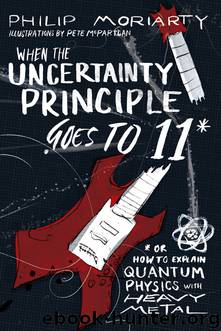When the Uncertainty Principle Goes to 11 by Philip Moriarty

Author:Philip Moriarty [Moriarty Philip]
Language: eng
Format: epub, mobi
ISBN: 9781944648534
Publisher: BenBella Books, Inc.
In these digitally enabled times, of course, we don’t need to use a Victorian era Telharmonium, or a Hammond organ, or a wall of Marshalls (or any combination thereof) to sum up signals. We can easily do Fourier synthesis on a computer. This is not as much fun as dealing with 200 tons of equipment, but it’s precisely the same underlying concept: we build up a signal from a set of different sine waves.37 And the uncertainty principle tells us that if the signal doesn’t last for long, we’re going to need a wide range of sine waves to represent it.
As we move from a sustained note to a chug and the frequency spectrum broadens, we’ll need to use a larger number of signal generators—whether tone wheels in the nineteenth century, or simply more digital signals on a laptop/iPad in the twenty-first—covering a broader range of frequencies, to synthesize our kerrchunk.
How far can we take this? What if we have the shortest possible note ever? A note so short that it’s beyond the capabilities of even the fastest shredder to play. A chug that lasts for an infinitesimal amount of time. What then does the frequency spectrum become?
We’ve seen that an infinitely sustained note—that never-ending whistle—has a perfectly narrow frequency spectrum: a delta function spike. Remember that all-important reciprocal relationship between frequency and time that’s the core message of the uncertainty principle: infinitely wide in time means infinitesimally narrow in frequency. And vice versa.
So, if we have an infinitesimally short chug—in other words, a delta function spike in time—its frequency spectrum will be infinitely wide. To create the shortest possible sound, we need the widest possible range of frequencies. And we need to ensure that the infinity of sine waves all line up in precisely the right way so that they cancel out everywhere but for that infinitesimally short moment in time. If we put this in the context of the uncertainty principle once again, what Fourier tells us is that complete certainty as to when a note sounds translates to complete uncertainty about the frequency of that note. The uncertainty is so large that an infinitely wide band of frequencies is required to represent the note.
Walking back from infinity once again, but this time in the frequency domain, as we narrow the width of the spectrum we’ll find that our signal in time will broaden out. The longer a note sustains, the narrower the frequency spectrum becomes—as in the Tufnel sustain vs. the Hetfield chug.
Download
When the Uncertainty Principle Goes to 11 by Philip Moriarty.mobi
This site does not store any files on its server. We only index and link to content provided by other sites. Please contact the content providers to delete copyright contents if any and email us, we'll remove relevant links or contents immediately.
The Goal (Off-Campus #4) by Elle Kennedy(13192)
Kathy Andrews Collection by Kathy Andrews(11316)
Diary of a Player by Brad Paisley(7264)
What Does This Button Do? by Bruce Dickinson(5930)
Assassin’s Fate by Robin Hobb(5850)
Big Little Lies by Liane Moriarty(5507)
Altered Sensations by David Pantalony(4862)
Pale Blue Dot by Carl Sagan(4612)
Sticky Fingers by Joe Hagan(3906)
The Death of the Heart by Elizabeth Bowen(3333)
The Heroin Diaries by Nikki Sixx(3314)
Beneath These Shadows by Meghan March(3145)
Confessions of a Video Vixen by Karrine Steffans(3098)
The Help by Kathryn Stockett(3013)
How Music Works by David Byrne(2958)
Jam by Jam (epub)(2872)
Harry Potter 4 - Harry Potter and The Goblet of Fire by J.K.Rowling(2797)
Strange Fascination: David Bowie: The Definitive Story by David Buckley(2699)
Petty: The Biography by Warren Zanes(2572)
